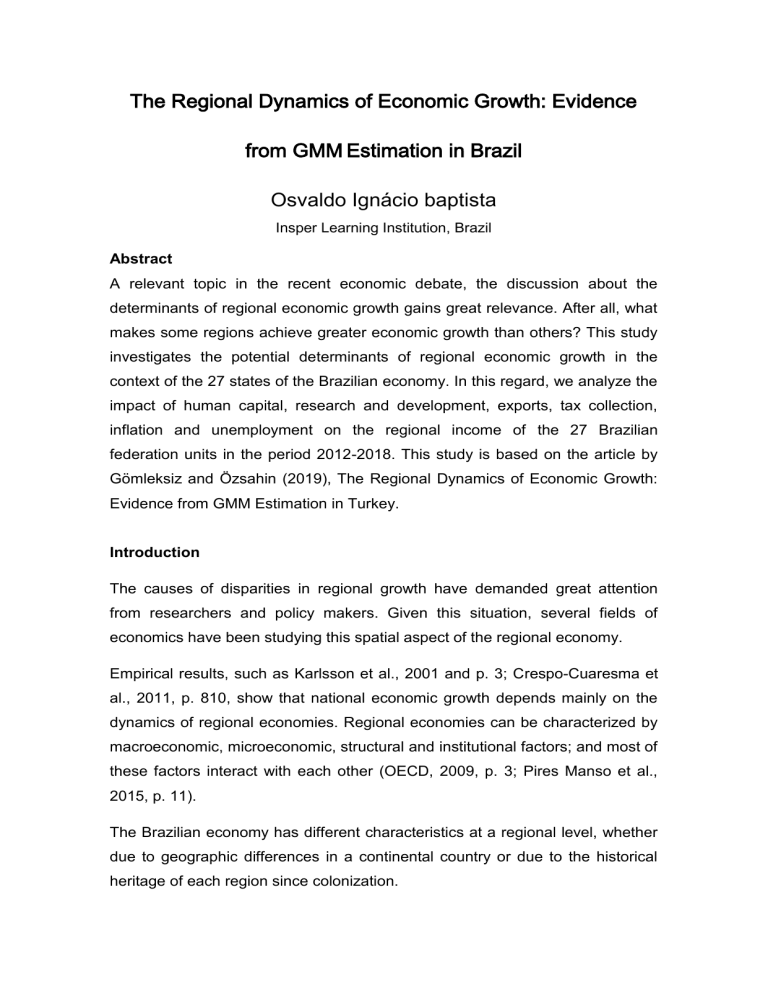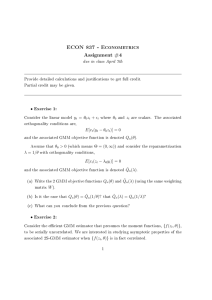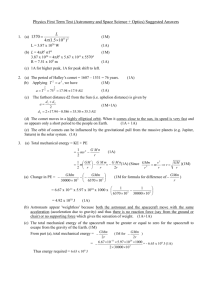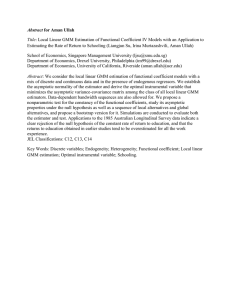The Regional Dynamics of Economic Growth Evidence
advertisement

The Regional Dynamics of Economic Growth: Evidence from GMM Estimation in Brazil Osvaldo Ignácio baptista Insper Learning Institution, Brazil Abstract A relevant topic in the recent economic debate, the discussion about the determinants of regional economic growth gains great relevance. After all, what makes some regions achieve greater economic growth than others? This study investigates the potential determinants of regional economic growth in the context of the 27 states of the Brazilian economy. In this regard, we analyze the impact of human capital, research and development, exports, tax collection, inflation and unemployment on the regional income of the 27 Brazilian federation units in the period 2012-2018. This study is based on the article by Gömleksiz and Özsahin (2019), The Regional Dynamics of Economic Growth: Evidence from GMM Estimation in Turkey. Introduction The causes of disparities in regional growth have demanded great attention from researchers and policy makers. Given this situation, several fields of economics have been studying this spatial aspect of the regional economy. Empirical results, such as Karlsson et al., 2001 and p. 3; Crespo-Cuaresma et al., 2011, p. 810, show that national economic growth depends mainly on the dynamics of regional economies. Regional economies can be characterized by macroeconomic, microeconomic, structural and institutional factors; and most of these factors interact with each other (OECD, 2009, p. 3; Pires Manso et al., 2015, p. 11). The Brazilian economy has different characteristics at a regional level, whether due to geographic differences in a continental country or due to the historical heritage of each region since colonization. Since 1970, Brazil has been divided into 5 geographic regions (North, Northeast, Midwest, Southeast and South) and is also regionalized into 3 economic macro-regions (Center-South, Amazon and Northeast). While the Center-South region has the best economic and social indicators, it has a diversified economy and most of the country's industries are concentrated in this region; the Amazon region (comprised of almost all the states covered by Amazonian vegetation) is less densely populated and has a more restricted industrial activity, with worse access to social, education and infrastructure and worse economic development (economic and social indicators) . The Northeast region, where the semi-arid climate prevails, was highly explored in the colonial period, leaving behind a region with serious economic, social and structural problems. In this context, the objective is to investigate the set of factors that may be relevant to explain the differences in regional growth in Brazil. On potential determinants of regional economic growth, we are going to analyze human capital, research and development (R&D), exports, tax collection, inflation and unemployment in all 27 units of the federation (UF) of Brazil. In this study, we will use the difference GMM estimation method (Arellano and Bond, 1991) to control the potential problem of endogeneity in the estimates, by combining endogenous growth factors with fundamental structural factors. The data used in the analysis did not come from the Brazilian Institute of Geography and Statistics (IBGE), the National Institute of Industrial Property (INPI), the National Institute of Educational Studies and Research Anísio Teixeira (INEP) and the Ministry of Economy. In the remainder of the paper, section 2 discusses the factors that affect regional growth, section 3 presents the dataset and the econometric model used in the analysis, section 4 summarizes the empirical results, and section 5 concludes the article. Dynamics of regional economic growth and empirical literature In the economic literature, economic growth and its determinants have been analyzed from different perspectives and, although there is no consensus on its main determinants, we will continue in line with the determinants postulated by Gömleksiz and Özsahin (2019). In this context, human capital is defined as the accumulation of time spent on education and training, this indirectly contributed to productivity and growth through learning and increased level of skill and talent (Mathur, 1999, p. 210). According to (Farole, 2013, p. 22) international trade is also an important engine of growth in the short and long term. These contacts on education and international trade are supported by empirical studies such as Soukiazis and Antunes (2011) which show that human capital and exports are relevant factors in explaining regional growth and convergence in Portuguese regions in the period 1996-2005. The formation of R&D also comes from the combination of physical and human capital is considered another determining factor of economic growth through innovations (RodríguezPose and Crescenzi, 2008, p. 53), Pakes (1985) also shows that current and past changes in R&D has a significant effect on US patent application counts in the 1968-1975 period and Kaldei and Walz (2001) indicate a significant positive relationship between the average growth rate of GDP per capita and patent applications for 11 EU regions analyzed . Another factor that can be important in economic growth is related to public intervention, Hirschman (1958) assesses that the government has a positive impact on the economy through the allocation of resources in areas such as education, infrastructure, health and investments. Thus, the allocation of resources and the size of the government budget can induce the economic efficiency of a UF, in this context Mıhçı and Köksal (2010) conclude that public investment has a negative impact on regional growth per capita in a study covering the 65 provinces of the Turkey in the period 1980-2000, a result that diverges from the study by Önder et al (2010) in the context of the 26 NUTS 2 regions of Turkey for the same period. Unemployment is another factor whose link to economic growth is much debated, as high unemployment can be considered as one of the main causes of poverty and also indicates an inefficient use of resources, thus Reinstadler and Ray (2010) note that unemployment at the regional level it probably negatively affects individuals with low income levels due to the decrease in work and pressure on wages, empirically Bere et al (2014) conclude by examining Romanian cities in the period 1996-2010 that unemployment has a negative impact on the GDP per capita, while spending on R&D positively affects economic growth. Inflation, on the other hand, can also have a negative effect on well-being and economic growth according to Friedman (1977), Fischer (1993) also states that inflation hinders growth by reducing investment and productivity, Shevchuk (2014) investigates the determinants of growth in 26 Ukrainian regions in the period 2002-2012 and its results point to a significantly negative effect of inflation on per capita production (although this same study concluded that per capita exports also have a negative effect). Dataset and Econometric Model In this study we used the Difference GMM (Generalized Method of Moments) dynamic panel estimation method (Arellano and Bond, 1991) in order to investigate the dynamics of regional growth in Brazil. Estimates were performed with robust standard errors against the potential endogeneity problem. The data set used in the study consists of data from 27 states (26 states and the Federal District) in the period 2012-2018. Data are obtained at the regional level and used in a logarithmic way. In table 1, GDP per capita is expressed in Reais (R$). In relation to R&D, we consider the statistics of invention patents, utility model and industrial design registration in line with the empirical literature that postulates that patents are considered as one of the main results of R&D (Pakes, 1985). In the case of human capital, there are controversies about the best measure and we will follow according to Gömleksiz and Özsahin (2019) and we will use the percentage of graduates in each region. In the case of inflation, we will measure this variable through the IPCA, which is I calculate for the IBGE for a set of capitals and metropolitan regions and we are considering the inflation of each capital or metropolitan region as representative for the entire state. In the case of states other than whose capital is not included in the IPCA survey, we will consider the IPCA of the nearest metropolitan region. As far as international trade is concerned, we will use the volume of exports per capita by region. We will use the IGBE unemployment statistics to calculate the unemployment rate and finally, we will measure the tax collection of each state through the Ministry of Economy's data on the collection of each UF. lpcgdpit = α0 + α1lpcgdpi,t-1 + α2lrdit + α3lhumit + α4lexit + α5ltrit + α6linfit + α7lunmpit + ηi + μt + εit In the above equation, ηi is the specific individual effect that takes the unobservable heterogeneity between the cross section units into account, μt is the time specific effect. While i denotes the cross section units, t represents the time dimension and εit is o error term. lpcgdpi,t-1 is one year behind GDP per capita in logarithmic form. This variable is also included in the long-term equation as the instrumental variable to eliminate the problem of endogeneity in the regression. In the analysis, we used the xtabond2 command in STATA. Variable Economic Growth Research and Development Human Capital Exports Tax Revenue Inflation Unemployment Table 1. Definitions and Sources of Variables Abbreviation Indicator Source lpcgdp Real GDP per capita IBGE (2018) Patent Applications per lrd INPI (2018) 100,000 persons Share of tertiary lhum education graduates in INEP (2018) total population lex Total volume exports Ministério da Economia (2018) ltr Per capita tax revenue Ministério da Economia (2018) linf IPCA IBGE (2018) lunmp Unemployment rate IBGE (2018) As (Guetat and Sridi, 2017, p. 91), in dynamic panel analysis, estimators require the use of instruments as a lagged form of endogenous variables. These estimators are a good choice if there is a functional relationship between the variables, or the present value of a variable of the dependent variable depends on its past values, or when the independent variables are not strictly exogenous (Roodman, 2009, p. 86). A method that proposes to solve these problems is Arellano and Bond (1991), this method considers the unobserved heterogeneity and predetermined regressors. In this method, it first takes into account the first difference of the equation in order to eliminate specific unobserved effects in the long-term regression. This method performs well when the cross section is relatively larger than the time dimension (Moral-Benito et al., 2017, p. 7-8). Applying the difference or 1-step difference GMM method (Arellano and Bond) to the dynamic growth model as a first difference regression: lpcgdpit - lpcgdpi,t-1= μt - μt-1 + α1lpcgdpi,t-1 + α2lrdit + α3lhumit + α4lexit + α5ltrit + α6linfit + α7lunmpit + εit However, this method is criticized as it has some biased results in small samples. When variables approach a random walk, lagged levels often turn out to be weak instruments for first difference. To overcome these problems, the GMM system estimator was developed (Arellano and Bover, 1995; Blundell and Bond, 1998), this method includes some additional moment conditions based on two equations (the ―original equation‖ and the ―transformed into differences‖). These methods are called two-step difference GMM. Bond et al. (2001) argue that in case the time series is persistent and the number of observations in the time series is small, the GMM difference is poorly behaved, however the two methods are asymptotically equivalent. Despite the advantages, especially of the GMM system, they have the disadvantage of converging to their asymptotic form slowly compared to Monte's experiments (Carlo Bond et al., 2001, p. 3-18). The GMM system allows more instrumental variables than the GMM difference, improving the estimation power (Roodman, 2009, p. 86). The first equation of the GMM system is the same equation as the first step of the GMM difference, the level equation is given by the equation below: lpcgdpit = α1lpcgdpi,t-1 + α2lrdit + α3lhumit + α4lexit + α5ltrit + α6linfit + α7lunmpit + ηi + μt + νit We will evaluate the consistency of the results through two tests, firstly to assess the existence of first and second order autocorrelation, and additionally we will check if there is a problem of overidentification (Hansen test). In the case of the autocorrelation problem, (Mileva, 2007) observes that the difference of the GMM method often rejects the null hypothesis that the first residual differences are serially uncorrelated in the AR(1) process and considering the consistency of the estimator GMM, it is suggested that the first residue differences are not correlated in the AR process (2) (Hou and Chen, 2013, p. 188). Empirical Results In the table 2 we can see the results of the estimates of the GMM difference. With the exception of the first lag of GDP itself, all other explanatory variables had their relevance rejected (with 95% confidence), although for the model the F test rejects the null hypothesis with 95% confidence. Autocorrelation and Hansen tests show that there are no autocorrelation and overidentification problems in the model, indicating, to some extent, the robustness of the model. lpcgdpi,t-1 lrdit lhumit lexit ltrit linfit lunmpit Table 2. Results of Panel GMM Arellano and Bond (1991) Corrected [95% conf. t P>|t| The Difference Std. Error interval] GMM 0.643 0.284 2.270 0.032 0.060 1.227 0.001 0.019 0.040 0.970 0.039 0.041 0.232 0.496 0.470 0.645 0.788 1.252 0.010 0.027 0.360 0.720 0.046 0.066 -0.005 0.088 0.060 0.956 0.186 0.176 0.007 0.021 0.320 0.748 0.036 0.050 0.001 0.042 0.030 0.974 0.086 0.089 AR(1) AR(2) -1.26(0.206) -0.68(0.496) Hansen test 19.31(1.000) Let's now analyze the estimates according to the GMM system approach, for this case we chose STATA's xtdpdsys function. xtdpdsys fits dynamic panel data estimators with the Arellano – Bover / Blundell – Bond system. After testing several functional forms, we identified that from the third lag of explanatory variables onwards, we were able to reject the self-relationship hypothesis through the Arellano-Bond test. In this model, we have reasons to suspect that the strict exogeneity hypothesis is very strong, so we will weaken it to the hypothesis that the variables are only predetermined, that is, the error term of period t is not affected by the explanatory variables of period ts, for every 1 ≤ s. In the table 3 we can evaluate the results obtained. In this case, we were able to reject the null hypothesis for all explanatory variables, with the exception of inflation. This exception may come from the fact that we do not have the IPCA value for capitals of all states (in this case we had to consider the inflation of the closest capital in the case of states not included in the IPCA survey), this hypothesis may have reduced the IPCA variability across states, leaving us with no evidence to reject the null hypothesis. Also in System GMM, the autocorrelation tests indicate that there is no evidence of a specification problem, thus supporting the robustness of the model. lpcgdpi,t-1 lrdit lhumit lexit ltrit linfit lunmpit AR(1) AR(2) Table 3. Results of Panel GMM Arellano and Bover (1995), Corrected z Blundell and Bond (1998) Std. Error The System GMM 0.883 0.054 16.27 0.027 0.014 2.02 1.207 0.555 2.17 0.048 0.022 2.17 0.433 0.173 2.51 0.000 0.019 -0.02 -0.083 0.051 -1.64 P>|z| 0.000 0.043 0.030 0.030 0.012 0.984 0.101 [95% conf. interval] 0.776 0.001 0.119 0.005 0.095 -0.038 -0.183 0.989 0.054 2.295 0.092 0.772 0.037 0.016 -1.79(0.730) 1.0162(0.309) The Difference GMM ended up not being able to verify the relevance of the analyzed variables as potential determinants for the dynamics of regional growth, however, when we weakened the hypothesis of strict exogeneity for predetermined variables and used the System GMM, which behaves better in smaller samples, we found that the unemployment has a negative impact on economic growth, while inflation varied in sign according to the estimation method used, but in neither case was it relevant. The other variables: R&D, education, foreign trade and tax collection affect regional economic growth. This result is in line with most of the results obtained in the work by Gömleksiz and Özsahin (2019), on which this paper is based, with two exceptions: for data from Turkey, the results show inflation as a variable, different from that obtained for Brazil, the limited availability of IPCA data for Brazil is a possible explanation for this difference. On the other hand, for data from Brazil, the results show relevance of R&D for regional economic growth, while for data from Turkey this variable was not significant. Final remarks In this study, we could verify that regional economic growth in Brazil has been negatively affected by unemployment and positively affected by human capital, R&D, international trade and tax collection in each unit of the federation. These factors emerge as potential determinants to explain economic disparities between different regions of Brazil. Human capital is shown to be a crucial element for economic growth in Brazil and, not surprisingly, in line with the result obtained by Gömleksiz and Özsahin (2019) for data from Turkey. In this way, we can see the dynamizing effect of human capital on economic growth as emphasized in endogenous growth models. The relevance of R&D to regional economic growth also sheds light on the potential combination of human capital and learning, which can leverage R&D training and thus a greater stock of knowledge at a regional level (Gömleksiz and Özsahin, 2019). The System GMM results also indicate the relevance of international trade for economic growth. This allows for economies of scale, allowing the production of more competitive goods and technology transfer (Gömleksiz and Özsahin, 2019). The results of the study also indicate the contractionary effect on the regional per capita in the System GMM, thus a high rate of unemployment can also harm the efficient use of resources and disfavor regional production. Finally, another variable that proved to be relevant in the Brazilian context was tax collection. It is worth noting in this case, in the study by Gömleksiz and Özsahin (2019), the variable considered was public investment. Unfortunately, this information at regional level is only available in the period from 2017 onwards, making a robust model unfeasible. Faced with this impossibility, we tested a series of proxies, such as total collection per UF per capita (adding tax collection and transfers received), but the results proved contradictory. Investigating further, we find that the states that receive the most transfers per capita are the poorest states, while a rich state like São Paulo is the second that received the least transfers in 2018 for example. Thus, we had the sum of two variables that vary divergently with economic growth: while per capita transfers vary negatively with each state's GDP per capita, it is to be expected that tax revenue will grow with the increase in GDP. Thus, the inclusion of tax collection alone as a proxy has shown to have greater potential, and it is to be expected that a state with a higher budget per inhabitant will allocate a greater amount to public investment (although this is not necessarily true if we analyze the proportion budget allocated to public investment). References Bere, R. C., Otoiu, A., & Bucerzan, I. (2014). Determinants of economic growth in cities acting as growth poles in regions from Romania. Procedia Economics and Finance, 10(2014), 357-365. Crespo-Cuaresma, J., Foster, N., & Stehrer, R. (2011). Determinants of Regional Economic Growth by Quantile. Regional Studies, 45(6), 809-826. Farole, T. (2013). Trade, Location and Growth. In T. Farole (Ed.), The Internal Geography of Trade: Lagging Regions and Global Markets (pp.15-32). The International Bank for Reconstruction and Development, Washington DC: The World Bank. Fischer, S. (1993). The role of macroeconomic factors in growth. Journal of Monetary Economics, 32(3), 485-512. Friedman, M. (1977). Nobel lecture: inflation and unemployment. Journal of Political Economy, 85, 451-472. Gömleksiz,M., Özsahin,S. (2019). The Regional Dynamics of Economic Growth: Evidence from GMM Estimation in Turkey. Applied Economics Journal Vol. 26 No. 1 (June 2019): 71-100 Guetat, I., & Sridi, D. (2017). Institutional quality effect on remittances in MENA region. Middle East Development Journal, 9(1), 84-100. Kaldewei, C., & Walz, U. (2001). The Determinants of Regional Growth in Europe: An Empirical Investigation of Regional Growth Models (Working Paper). Retrieved from Goethe University website: https://www.wiwi.unifrankfurt.de/profs/walz/REGGRO4.pdf Karlsson, C., Johansson, B., & Stough, R. (2001). Introduction: Endogenous Regional Growth and Policies. In B. Johansson, C. Karlsson, R.R. Stough (Eds.), Theories of Endogenous Regional Growth: Lessons for Regional Policy (pp. 3-16). Heidelberg: Springer. Mathur, V. K. (1999). Human Capital-Based Strategy for Regional Economic Development. Economic Development Quarterly, 13(3), 203-216. Mıhçı, S., & Köksal, M. Z. (2010). Determinants of Cross-Regional Income Differentials: The Case of Turkey. H.Ü. Iktisadi ve Idari Bilimler Fakültesi Dergisi, 28(2), 71-94. Moral-Benito, E., Allison, P., & Williams, R. (2017). Dynamic panel data modelling using maximum likelihood: an alternative to Arellano-Bond (Documentos de Trabajo No.1703) Önder, A. Ö., Deliktas, E., & Karadag, M. (2010). The Impact of Public Capital Stock on Regional Convergence in Turkey. European Planning Studies, 18, 1041–1055. Pakes, A. (1985). On patents, R & D, and the stock market rate of return. Journal of Political Economy, 93(2), 390-409. Pires Manso, J. R., Fernandes de Matos, A. J, & Carvalho, C. C. M. (2015). Determinants of Regional Growth in Portugal: An Empirical Analysis. Economics and Sociology, 8(4), 11-31. Reinstadler, A., & Ray, J-C. (2010). Macro Determinants of Individual Income Poverty in 93 Regions of Europe (CEPS Working Paper No. 2010-13). Rodríguez-Pose, A., & Crescenzi, R. (2008). Research and development, spillovers, innovation systems, and the genesis of regional growth in Europe. Regional Studies, 42(1), 51-67. Roodman, D. (2009). How to do xtabond2: An introduction to difference and system GMM in Stata. The Stata Journal, 9(1), 86-136. Shevchuk, V. (2014). Regional Growth Determinants in Ukraine: Panel Data Estimates. Acta Universitatis Lodziensis Folia Oeconomica, 5(307), 113-124. Soukiazis, E., & Antunes, M. (2011). Is foreign trade important for regional growth? Empirical evidence from Portugal. Economic Modelling, 28, 1363– 1373. xtdpdsys — Arellano–Bover/Blundell–Bond linear dynamic panel-data estimation, Stata Manuals. Retrieved from https://www.stata.com/manuals/xtxtdpdsys.pdf>




